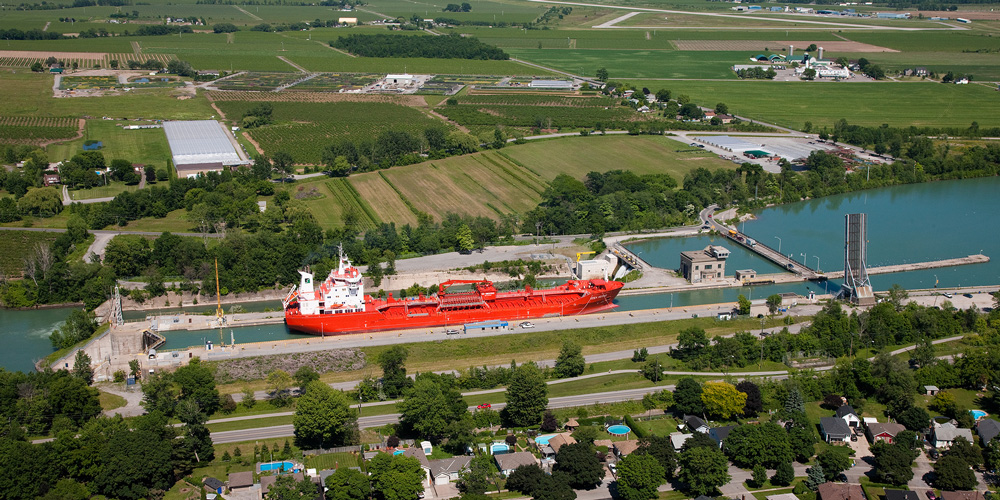Seaway Wraps Up 2015 Navigation Season with OECD Innovation Award Under its Belt
January 12, 2016
Cornwall, Ontario (January 12, 2016) – With water temperatures well above the 10-year average, the St. Lawrence Seaway closed its 2015 navigation season ice free on December 31st. Thirty-six million tonnes of cargo transited the waterway during the season, with grain, at volumes well above the five-year average, leading the way. The Seaway once again proved to be a key asset for farmers as they shipped their crops to markets at home and overseas.
Grain volumes on the Seaway amounted to 10.8 million tonnes, one of the strongest years in recent memory. The Port of Thunder Bay, the principal point of entry for grain into the Great Lakes / Seaway System, reported its second-best season in 15 years. Combined with grain being loaded onto ships from other ports such as Hamilton, Duluth / Superior and Toledo, agricultural commodities have become increasingly important to the Great Lakes / Seaway System.
Terence Bowles, President and CEO of The St. Lawrence Seaway Management Corporation (SLSMC), noted that “the Seaway continues to serve as a vital trade artery, enabling cargo to move to more than 50 countries across the globe.”
In May, the SLSMC received the Promising Innovation in Transport Award by the International Transport Forum at the OECD, during the 2015 Summit of Transport Ministers held in Leipzig, Germany. The award recognized the SLSMC’s pioneering work in developing, with the supplier Cavotec, the world’s first Hands-Free Mooring (HFM) system for ships transiting locks. The use of this equipment will largely replace the traditional practice of manually securing ships in locks with steel mooring lines, enabling the Seaway to orchestrate gains in operating efficiency and safety, and become yet more competitive.
On this subject, Terence Bowles said “the OECD’s recognition of the Seaway’s work on Hands Free Mooring underscores the value of the innovative spirit demonstrated by our employees, a quality that is essential to success in today’s global economy. With strong support from a wide variety of stakeholders, we are setting the stage for a thoroughly modern lock operating system, which will ensure the Seaway’s future competitiveness and sustainability well into the 21st century, and attract more vessels to use our waterway.”
The 2015 season opened on April 2nd, about a week later than usual, reflecting the frigid conditions in early spring, and closed on December 31st with the passage of the vessel Mississagi through Welland Canal Lock 1 at 3:41 AM. The last vessel to exit the Montreal / Lake Ontario section was the Baie St. Paul, which exited the St. Lambert Lock at 8:41 PM on December 30th. The 2015 navigation season was 274 days in length.
“Now that the navigation season has concluded, winter maintenance projects at the U.S. Snell and Eisenhower locks are already underway. The maintenance of the U.S. locks is a year round job and Seaway employees are diligently working as we continue to rehabilitate and modernize the Seaway infrastructure under our Asset Renewal Program” said Betty Sutton, Administrator of the U.S. Saint Lawrence Seaway Development Corporation. “The 2015 navigation season saw highs and lows in traditional cargoes that move through the Seaway System. Global demand for coal remained below last year’s levels whereas general cargo to and from international and domestic markets remained high with over a 100% increase. Project cargo and dry bulk materials to support the construction and manufacturing industry also remained in positive standings.”
Quick Facts:
- The Great Lakes / Seaway System is a “marine highway” that extends some 3,700 km from the Atlantic Ocean to the Great Lakes. Approximately 160 million tonnes of cargo travels over the combined Great Lakes / Seaway System on an annual basis, supporting over 227,000 jobs and $35 billion in economic activity.
- The binational St. Lawrence Seaway serves as the linchpin within the Great Lakes / Seaway System, connecting the lower St. Lawrence River to the Great Lakes. Beginning in Montreal and extending to points west, the Seaway’s 15 locks (13 Canadian and 2 U.S.) enable ships to climb a total of 168 metres from “sea level” up to Lake Erie. For more information on the St. Lawrence Seaway, please consult the www.greatlakes-seaway.com website.
About The St. Lawrence Seaway Management Corporation:
- The St. Lawrence Seaway Management Corporation was established in 1998 as a not-for-profit corporation by the Government of Canada, Seaway users and other key stakeholders. In accordance with provisions of the Canada Marine Act, the Corporation manages and operates the Canadian assets of the St. Lawrence Seaway, which remain the property of the Government of Canada, under a long-term agreement with Transport Canada.






